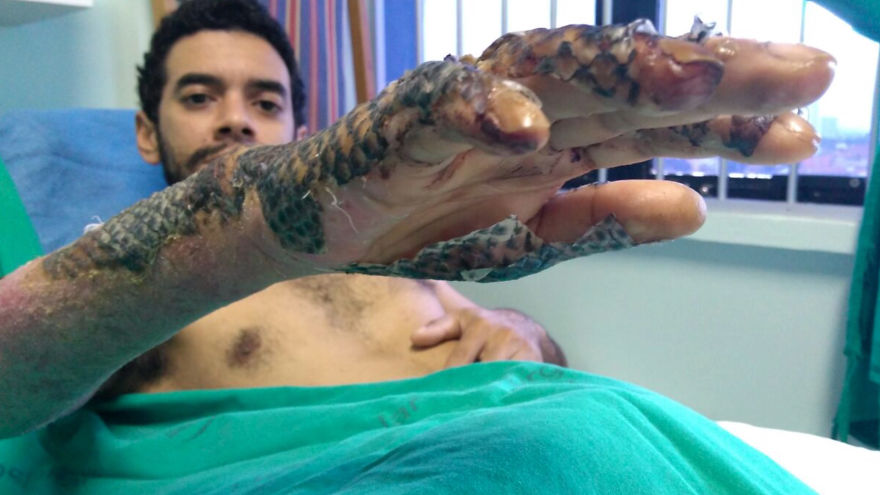The Story Of The Treatment Of Burns Using The Skin Of Tilapia Fish
926views
The video from ROVIDEO.NET is the story of the treatment of burns using the skin of Tilapia fish, a discovery made by medical researchers in Brazil.
The healing effect of the treatment is narrated using the experiences of Josue Bezerra Jr., an electrical supervisor from Brazil who suffered burns on the job.
Using an unusual bandage, the doctors wrapped his arm using sterilized tilapia skin, a treatment method he thought was weird at first.
He thought he looked like a mutant, but since doctors assured him the treatment would take less time to heal and cause less pain, he decided to be the first patient to try this method of treating skin burns.
According to Edmar Macie, the plastic surgeon, and coordinator of the tilapia skin study, the fish skin adheres to the skin wound and creates a buffer effect that prevents outside contamination.
This inhibits protein and moisture loss as it remains adhered to the wound until it heals.The study is the first of its kind in the world where the skin of an aquatic animal has been used for tests in burn patients.
Currently, the study is in its clinical stages though the lead coordinator is delighted they have admitted at least 52 patients for burn treatment using Tilapia skin strips, and none has experienced any form of complication.
The only discomfort with the treatment is during the process of replacing the traditional bandage wrapped around the wound, a process that can be hurting and painful.
However, patients with superficial burns do not have to experience the discomfort because the skin strips are only removed after full recovery from the burn, a process that takes 11 days on average.
The study was commissioned in Northeast Brazil, and this is advantageous because the region lacks an operational skin bank. The program promises to help people from the surrounding communities who suffer skin burns on many occasions, attests Bezerra Jr. He agrees that at first, he experienced pains though he was reassured by the doctors’ everything was normal.
Afterward, the burning pain receded without using antibiotics or pain medications, and the skin had begun peeling off after 13 days. The study was motivated by the fact that there are plenty of Tilapia skins in Brazil that fish farms normally throw away, and it is commendable medical research has unearthed their use, and they are currently applying their discoveries in offering affordable treatment for burns to a largely poor population in Northeast Brazil.
This is a tedious process because making the skins into odorless and sterile strips is a time-consuming process. The skin strips are soaked using an antibiotic chlorhexidine and antiseptic glycerol and later sent to Sao Paolo for sterilization to ensure they are protected from virus infections.
However, doctors agree the process of treating skin burns is both cost-effective and environmentally friendly, and after confirming tests concerning its safety, they hope it will be adopted in the country’s national health system. Even Bezerra attests the treatment is effective and safe, and in case he gets burnt again, he would boldly call for treatment with the Tilapia skin fish
More info: rovideo.net
The video from ROVIDEO.NET is the story of the treatment of burns using the skin of Tilapia fish, a discovery made by medical researchers in Brazil.
The healing effect of the treatment is narrated using the experiences of Josue Bezerra Jr., an electrical supervisor from Brazil who suffered burns on the job.
Using an unusual bandage, the doctors wrapped his arm using sterilized tilapia skin, a treatment method he thought was weird at first.
He thought he looked like a mutant, but since doctors assured him the treatment would take less time to heal and cause less pain, he decided to be the first patient to try this method of treating skin burns.
According to Edmar Macie, the plastic surgeon, and coordinator of the tilapia skin study, the fish skin adheres to the skin wound and creates a buffer effect that prevents outside contamination.
This inhibits protein and moisture loss as it remains adhered to the wound until it heals.The study is the first of its kind in the world where the skin of an aquatic animal has been used for tests in burn patients.
Currently, the study is in its clinical stages though the lead coordinator is delighted they have admitted at least 52 patients for burn treatment using Tilapia skin strips, and none has experienced any form of complication.
The only discomfort with the treatment is during the process of replacing the traditional bandage wrapped around the wound, a process that can be hurting and painful.
However, patients with superficial burns do not have to experience the discomfort because the skin strips are only removed after full recovery from the burn, a process that takes 11 days on average.
The study was commissioned in Northeast Brazil, and this is advantageous because the region lacks an operational skin bank. The program promises to help people from the surrounding communities who suffer skin burns on many occasions, attests Bezerra Jr. He agrees that at first, he experienced pains though he was reassured by the doctors’ everything was normal.
Afterward, the burning pain receded without using antibiotics or pain medications, and the skin had begun peeling off after 13 days. The study was motivated by the fact that there are plenty of Tilapia skins in Brazil that fish farms normally throw away, and it is commendable medical research has unearthed their use, and they are currently applying their discoveries in offering affordable treatment for burns to a largely poor population in Northeast Brazil.
This is a tedious process because making the skins into odorless and sterile strips is a time-consuming process. The skin strips are soaked using an antibiotic chlorhexidine and antiseptic glycerol and later sent to Sao Paolo for sterilization to ensure they are protected from virus infections.
However, doctors agree the process of treating skin burns is both cost-effective and environmentally friendly, and after confirming tests concerning its safety, they hope it will be adopted in the country’s national health system. Even Bezerra attests the treatment is effective and safe, and in case he gets burnt again, he would boldly call for treatment with the Tilapia skin fish
More info: rovideo.net
926views
Share on Facebook
 Dark Mode
Dark Mode 

 No fees, cancel anytime
No fees, cancel anytime 






4
2